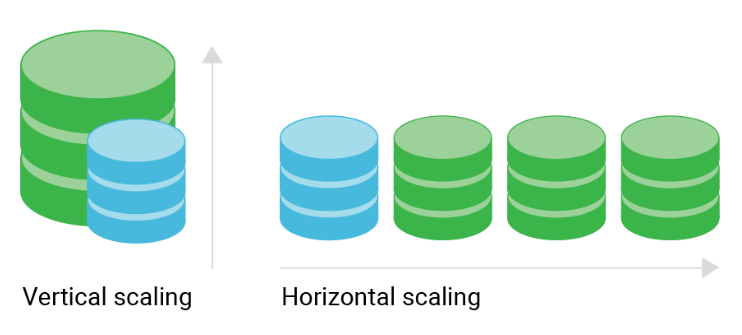Database scalability: handling large amounts of data and high traffic volumes
Keywords: Database, Scalability, high amounts, data
Database Scalability Definition
Database scalability refers to a database’s ability to handle increasing amounts of data, numbers of users, and types of requests without sacrificing performance or availability. A scalable database tackles these database server challenges and adapts to growing demands by either adding resources such as hardware or software, optimizing its design and configuration, or undertaking some combined strategy.
Database scalability is essential in applications that need (or anticipate the need) to handle large volumes of data, such as e-commerce, social media, and finance. A scalable database design can help businesses avoid bottlenecks, reduce downtime, and ensure a positive user experience even as demand increases.
Introduction:
Are you dealing with a lot of data and tons of people visiting your site? That’s where database scalability comes into play! It’s like giving your database the power to handle more and more work without slowing down. Let’s dive into the database scalability world using simple words everyone can understand.
Understanding Database Scalability:
Imagine your database as a superhero that needs to be ready for anything – more data, more people using your app, and lots of requests. Database scalability ensures your superhero database can handle all this without getting tired. It adds more resources, like extra computer power or space, changing its setup, or using various strategies.
Why Does It Matter?
If you run apps like online shops and social media or handle money transactions, you need a database that can grow with you. A scalable database design helps businesses avoid problems like slowing down, crashing, or causing trouble for users when there is a lot going on.
Scaling Tricks:

There are two main ways to make your database superhero stronger:
- Making It Bigger Inside (Vertical Scaling): Imagine giving your superhero a power-up by adding muscle, memory, or storage. It’s like making your computer taller or faster without changing much else.
- Calling for Backup (Horizontal Scaling): Instead of making your superhero bigger, you get more superheroes to share the workload. Each superhero handles a part of the job, making the team more powerful.
Apart from these, there are other excellent strategies:
– Sharding: Think of sharding as dividing your data into smaller groups and putting each group on different computers. It helps your database work faster.
– Federation: This strategy involves teamwork between databases, each handling a specific part of the job, like a group of friends working together.
– Hybrid Approaches: Some databases use a combination of the above strategies, combining the best of both worlds to handle data smartly.
Choosing the Right Database:
It’s like picking the right tool for the job. Different databases have different strengths:
– Relational Databases: These are like the experienced superheroes. They’ve been around for a while and can handle a lot. But they might need help finding it for vast amounts of data.
– NoSQL Databases: These are flexible databases that can easily handle big, messy data. They are perfect for things like social media and fast analytics.
– Hybrid Solutions: These are the best of both worlds. They keep things organized like old-school databases but can also handle a massive amount of data like new ones.
Why Should You Care?
- Speedy Performance: Your database stays fast, even when dealing with a mountain of data and many people using it.
- Always Ready: If one part of your database has a problem, another part steps up so your system keeps running smoothly. No more waiting around!
- Cost-Effective: You only pay for the computer power you need. It’s like paying for the exact number of seats you use on a plane.
- Ready for the Future: Scalable databases are like superheroes that can change. As your app grows, it grows with it, saving you from significant upgrades.
Tips for Smooth Sailing:
– Smart Organization: Arrange your data so it’s easy to find and use, reducing stress on your system.
– Indexing Magic: Use indexes to speed up specific tasks without slowing down the whole system.
– Caching Tricks: Save frequently used data in quick-to-access memory space, reducing the work your database has to do.
– Keep an Eye Out. Regularly check how your database is doing and fix problems before they get big.
In Conclusion:
The challenge of database scalability might sound tricky, but it’s like having a superhero that’s always ready for action. By understanding the simple tricks and tools available, anyone can make their database handle big data, and many users like a pro. In the world of digital challenges, those who can scale smoothly are the ones who rule the digital seas. So, fear not the data tsunami – ride it confidently and unlock its endless possibilities!
References:
- What is Database Scalability? Definition & FAQs | ScyllaDB
- https://nexusintegra.io/why-database-scalability-is-the-challenge-for-developers/
- https://www.freecodecamp.org/news/understanding-database-scaling-patterns/
- https://www.linkedin.com/pulse/secrets-database-scalability-pavan-belagatti?trk=public_post_main-feed-card_feed-article-content
- https://www.linkedin.com/advice/0/how-can-you-improve-database-scalability
- https://www.forbes.com/sites/adrianbridgwater/2022/07/04/what-does-it-scalability-actually-mean/


